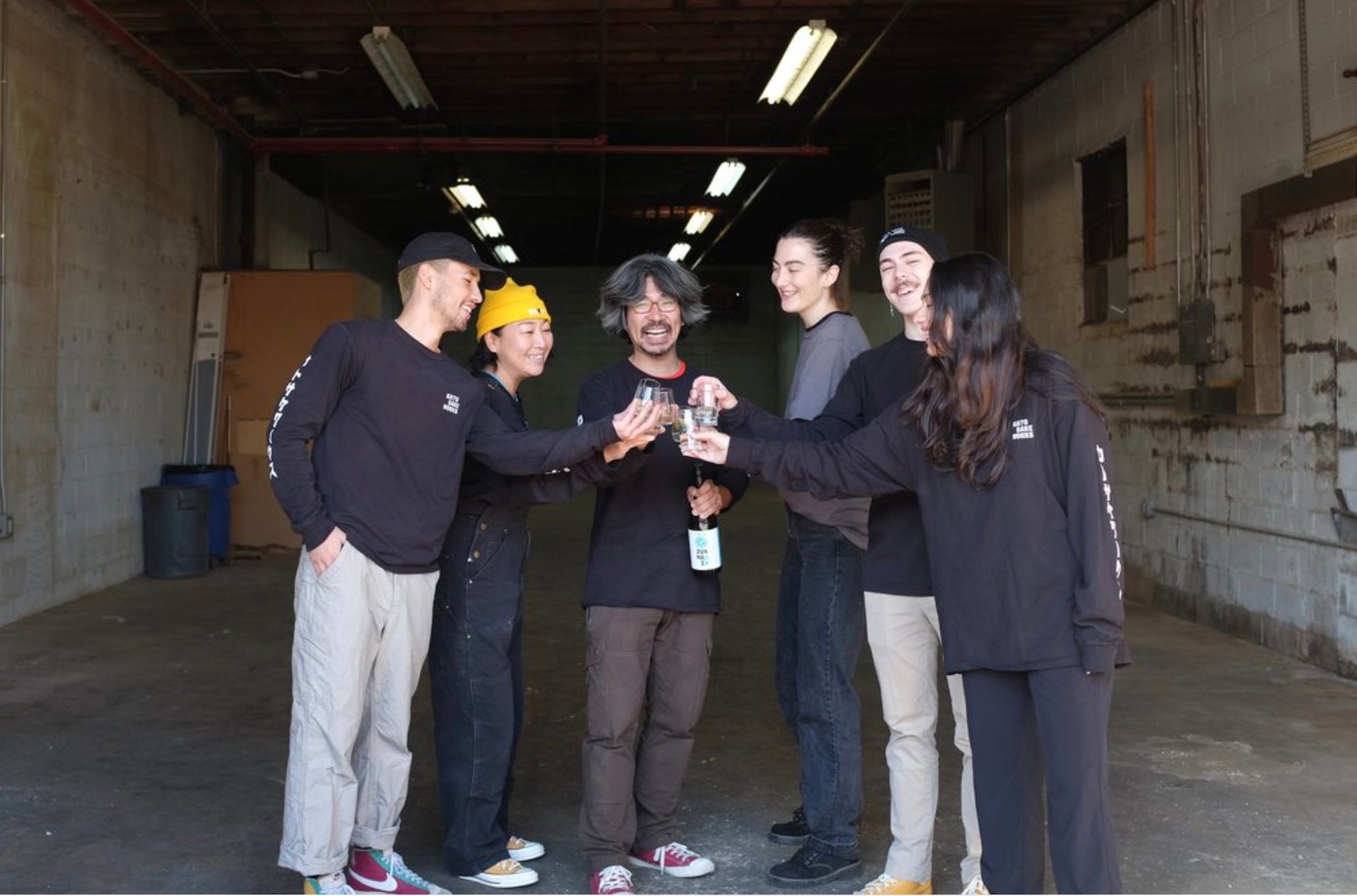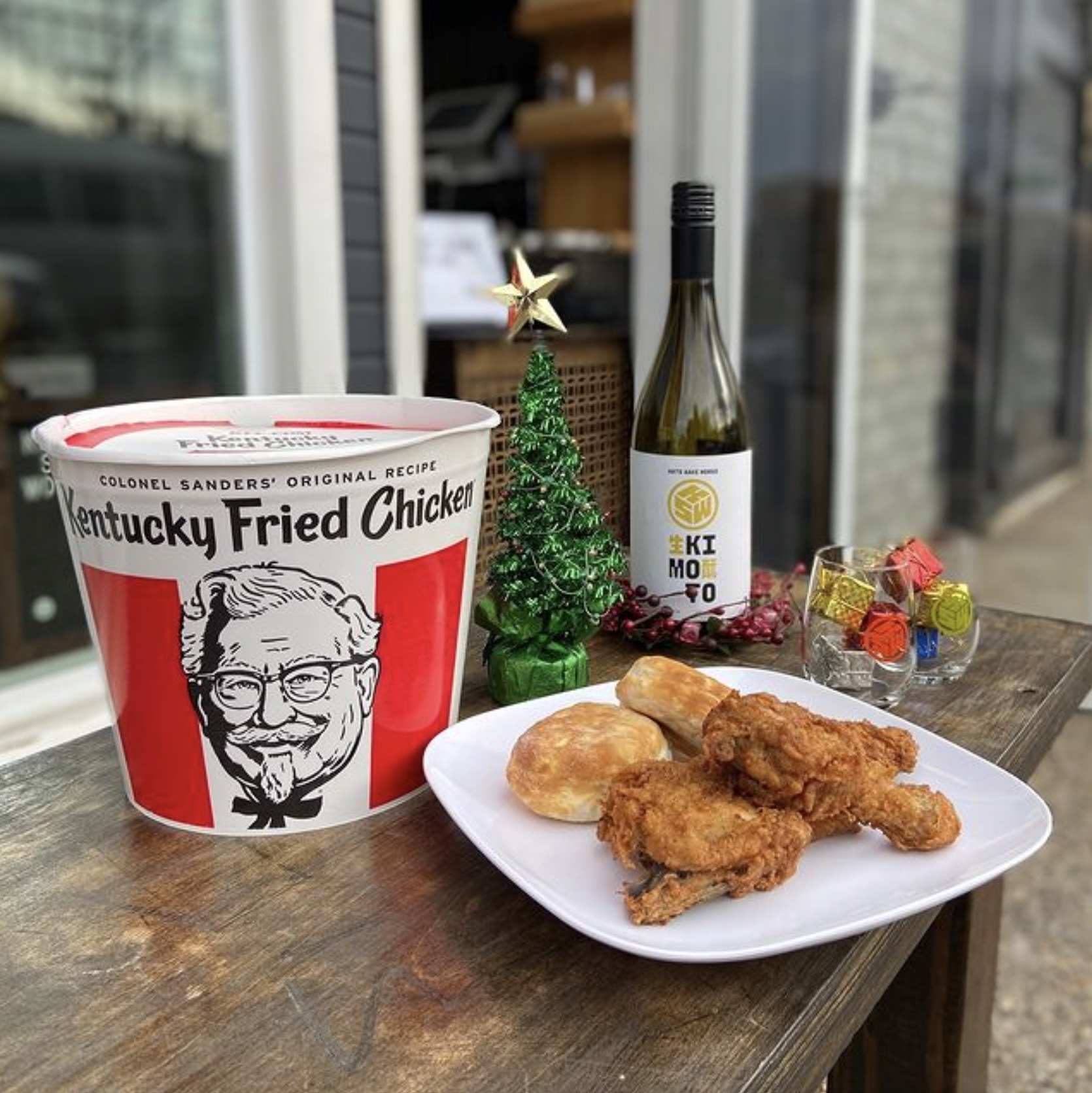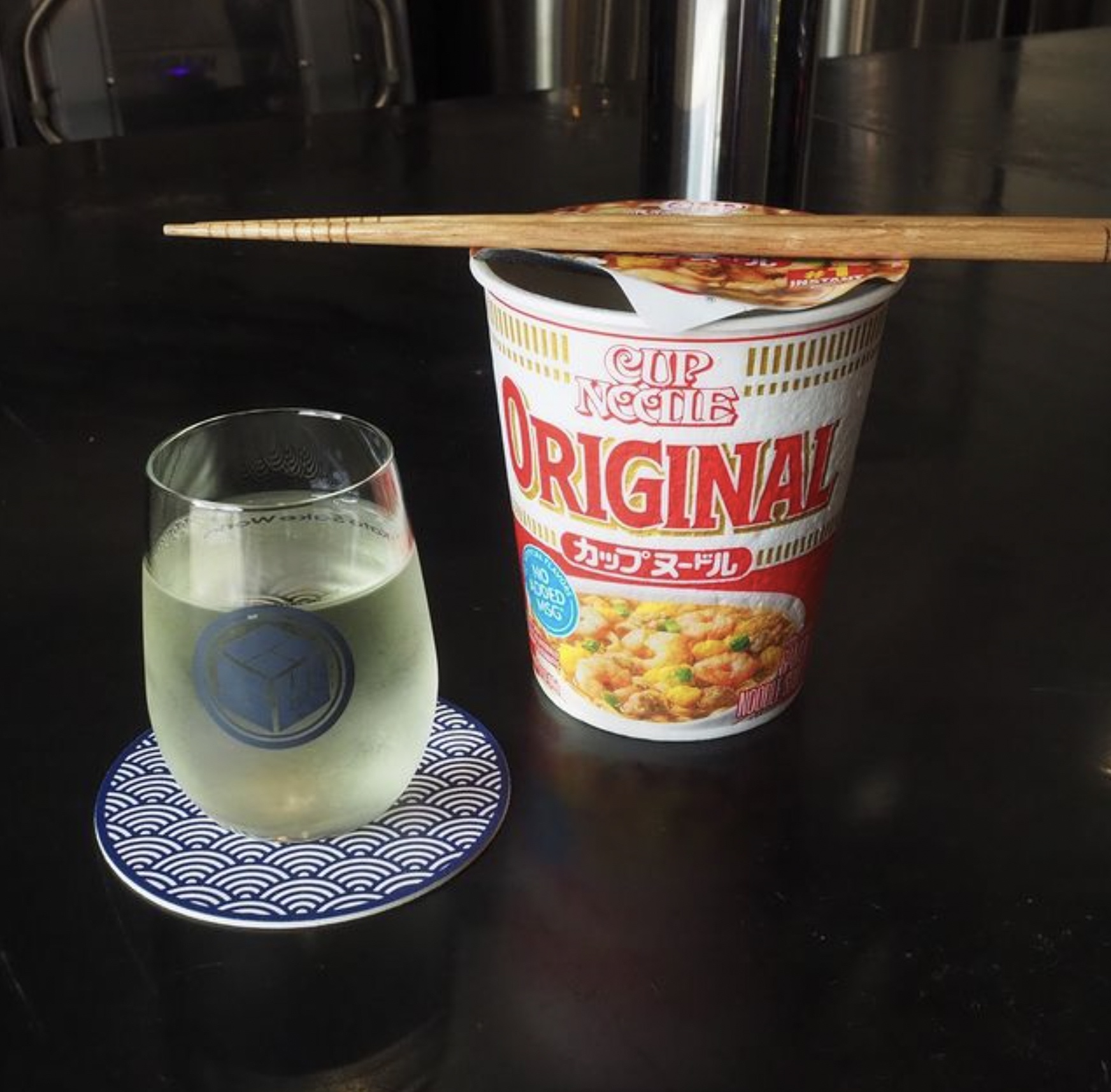In New York, where Japanese food is well-known, sake is usually paired exclusively with sushi and tempura. In the U.S., sake is often described as the white wine from Japan, but the production process is similar to that of beer. There are countless methods and types for the production process of sake, which leads to a wide variety of flavors.
The world of sake is deep. There is so much to learn as you delve into it. Fine sake is pretty expensive in New York, which makes it harder to enjoy it casually. Due to differences in food culture, it’s not the best to pair dishes such as pizza, tacos, and pasta with strong flavors to delicate sake to bring out the best of both. Does sake only go well with Japanese food? At least I thought so until I discovered Kato Sake Works (KSW), a sake brewery that combines junmai sake with pizza, nigori sake with pretzels and mustard, and raw sake with lamb kebabs, all of which are dishes commonly eaten in the U.S. Should I say they offer the perfect hybrid culture of sake and popular American food?
When you try the KSW brand sake, you will find that it is crisp on the palate, but has a robust personality in the aftertaste. It is delicately balanced, like the pairing of white wine and American food. Shinobu Kato, the owner and toji (brewer), grew up in Koenji, Tokyo. As a long-term resident of the U.S., he wanted to make sake at a place, which has the atmosphere of a yakitori bar under the railway tracks. It’s because he grew up along the Chuo-line, where Koenji is one of the stations with those types of yakitori bars. He now makes sake in Bushwick, Brooklyn, a tight-knit artistic community known for its vibrant graffiti walls.
The local pizzerias, cafes and bars, fusion restaurants, and other establishments, which have no ties with Japanese food, have been intrigued with the offerings at KWS. They have made inquiries to get their sake for their restaurants. Owners of neighborhood restaurants and residents visit KWS, saying that the store is unique. By word of mouth, they are expanding their customer base steadily. Fermented products require yeast including sake. Alcoholic fermentation is about repeating the process of nurturing and replicating the yeast. Similarly, KSW is attracting a diverse group of people, who love fermentation, and is growing its community steadily.

I want to offer opportunities for people to discover the tastiness of sake.
−−What prompted you to start Kato Sake Works and make sake? Were there any particular styles or flavors that you wanted to pursue?
Shinobu Kato (Kato): My American friends were making beer and wine, so I thought I’d give it a try to make sake by myself. In the beginning, I just learned by imitating the process. When you live abroad for a while, you start making miso and natto (fermented soybeans). I think it was close to that. As I made my own sake, I learned about the beauty and flavor of handmade sake. It was a completely different experience from enjoying sake bought at a store. When I made my first batch of sake, I thought, “Wow, it’s not so bad.” My friends liked it, too. I really enjoyed the process, which led me to start KSW.
−−Regarding the flavor of sake, is there a difference between the sake you like and the sake you sell?
Kato: In terms of business, I figured that the sake I sell in the U.S. would be slightly different from the flavor I usually like. The preference for food, as well as the occasions for people to drink sake are different. We can’t assume that what is appreciated in the U.S. would be accepted the same way in Japan. As for Japanese sake, the balance of sweetness and sourness is important. In the U.S., wine is popular and the food tends to be oily and has strong flavors. I have a vague idea that it would be better to create sake that would suit those aspects. The sake that we make at KSW is a kind that I personally want to drink, but I also want the Americans, who never tasted sake before to enjoy it casually and discover the taste of sake.
My favorite flavors are the full-bodied, junmai type with a strong aftertaste or sake made with the traditional Yamahai brewing method, which usually has a strong aroma. It’s a kind of sake that you can find at a small izakaya under the railway tracks along the Chuo line. I also enjoyed a rare brand I drank recently, which had a strong acidity. Although I am aware of the preference of Americans, I naturally end up making sake that is to my liking.
Sake lovers congregate in Bushwick to make sake
−−What is the setup for people to drink sake casually?
Kato: When I first came to New York, a friend invited me to a sake bar in Manhattan. Two American customers were having a good time looking at the extensive sake menu saying, “This is cool.” I believe they didn’t know how to choose sake, and I saw that they ordered the second cheapest sake. I guess that’s the best they could do. No matter how much the person serving the sake explains the difference between junmai and daiginjo, the sophisticated rice milling technology, or the quality of the ingredients, the customers are probably not so interested in those topics. In the U.S., people say that there has been a sake boom for the last 10 years. At the same time, they say that there is a lack of knowledge about sake among the customers. I believe that you can still enjoy drinking sake without having much knowledge. Currently there are not many sake connoisseurs versus those who drink and eventually intimately understand beer and wine in the States.
I spend time with experts and connoisseurs and talk to them about where the rice and water come from. For anyone interested, I explain the history and production process of sake. We are sake otaku (sake geeks) in that way and are truly fastidious about the details. However, I feel that we can keep that aspect to ourselves. I don’t see it as something that I want to use as a sales pitch to the customers. For most people out there, I think it’s more important for them if the sake tastes good or not, rather than having the knowledge about it. I always try to keep that in mind. I believe that the personality of the brewer is naturally reflected in the sake he or she makes. As for me, it’s not about trying to create sake that meets a certain standard. It’s more of a collaborative venture, where sake lovers gather in Bushwick to make sake.
There are breweries and tap bars near KSW, and most people just naturally get together at their favorite places to drink. I think that’s the right approach. Experience should come before education. It’s better to start with enjoying the atmosphere, the taste of sake, and realize that it’s quite delicious.
−−Do you want KSW to become a place where people from the neighborhood can drop by casually?
Kato: I think that our customers at KSW don’t know much about sake or haven’t yet discovered a brand that they find delicious. I chose “Junmai,” “Nigori,” and “Nama” as the name and taste of each sake to offer at KSW. The names are simple and are easy to remember. Do you remember using flashcards to memorize English words at school? I wanted to create flashcards for different kinds of sake. For example, people can drink the “Junmai” sake, while looking at the card. This is about learning and experiencing at the same time. When we present the card and the sake as a set, anyone who is interested will learn the difference in taste between the “Nigori” and the “Nama” and remember their names. Just like a student taking an exam, I would be happy if they could remember the names and tastes of at least two of the ten or so varieties they try. People, who can tell the difference between different kinds of sake, come to our place, too. I am sure these people know which restaurants serve good sake, and how to choose their favorite sake straightaway at a liquor store.
— When you founded KSW, you started with three types of sake: “Junmai,” “Nigori,” and “Nama”. Now, you added “Yuzushu” and “Mirin.” What kind of sake do you plan to make in the future?
Kato: I would like to try all of the sake production methods that have been established to date. The production method is also connected to the naming process, and I would like to gradually increase the variety of sake at KSW. I would like to find ways to explain things as simple as possible so that customers can understand the different names and tastes. I want them to find their favorite type of sake. I would like to see more people choosing the sake they like when they go to a restaurant or bar.
We have staff with a background in wine and beer. We also have staff with knowledge about fermentation. I think it will be interesting to combine their knowledge and experience with the production of sake. We are currently working on this idea.
It’s more important and satisfying to connect with the people in the local community and to receive their reactions personally than rapidly expanding far and wide.
−−Do you know any particular way of enjoying sake that is unique to your local customers?
KATO: I made “Mirin” simply because I wanted some otoso for the New Year. Otoso is traditionally drunk during the New Year celebration, and the ingredients are sake, mirin, and spices. I didn’t expect that it would sell so well. Recently, they started to sell mirin for drinking in Japan. However, we are not used to drinking mirin. And, I have not been able to explain to my customers successfully that it has the mouthfeel of sweet dessert wine. When you add spice to mirin and cook it for a while, the flavor turns bitter, and so some people drink it like bitters. Some people pour mirin over ice cream. The most popular sake is the “Junmai,” followed by the “Nigori.” But, I know customers who buy the “Mirin” frequently.


They introduce how to pair sake with food familiar to the Japanese.
(Left) Kentucky Fried Chicken and sake
(Right) Cup noodles and sake.
The store also sells Umaibo, a typical Japanese snack, made of puffed corn.
−−Could you tell us about your plan to open a taproom?
Kato: Lately, we don’t even know what’s going to happen in the next five or ten days. But we hope to open our next store by the end of this year. By then, we plan to increase our sake production tenfold from the current level. If we achieve that, we will finally be on the same scale as our competitors. At the same time, we hope that we can sell out all of our products in NYC. People tell us that we can eventually sell our products on the West Coast. However, I believe that there are still many places in NYC to expand our market. It includes entities that already sell sake and others which have the potential.
My top priority is for people in NYC who don’t know about sake to learn its appeal rather than trying to rapidly expand the market throughout the U.S. It is more important to connect with people in the immediate vicinity than trying to go far and wide.
Shinobu Kato
Shinobu Kato is the owner and brewer of Kato Sake Works, a craft sake brewery in Brooklyn, NYC. He held management positions in global companies in the US, India, Canada, and Japan as an expert in IT and business process improvement with experience in project delivery and operations. His passion for sake led him to leave his job and move to NYC to start a sake brewery in 2016. When Kato is not brewing sake in Bushwick, Brooklyn, a neighborhood that reminds him of his hometown Koenji, Tokyo, he enjoys cooking and DIY projects. His favorite ways to relax are backpacking and taking road trips.
https://www.katosakeworks.com/
KWS is currently holding a crowdfunding campaign until mid-March to expand its business. Anyone can invest online starting from $100.
https://mainvest.com/b/kato-sake-works-brooklyn
Translation Fumiko.M

